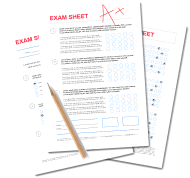If you're aiming for a high band score in the IELTS writing section, mastering IELTS Writing Task 1 is a must. Task 1 in IELTS writing is designed to test your ability to accurately explain and describe information presented in a visual, such as graphs, tables, or charts. A strong performance here can boost your overall writing score significantly. To help you, in our blog below, you will find everything regarding the writing task 1 IELTS, from types to tips on how to get a band score of 8. Read on!

Table of Contents
There are two tasks in the IELTS writing section. First is IELTS writing task 1, which is designed to test your ability to describe visual information. Whereas, in the IELTS writing task 2, you are assessed on how well you can write a clear and coherent English essay on various day-to-day topics.
In task 1 IELTS, you must describe and summarize information presented in a visual. These visuals can be graphs, charts, or tables, or they can be a diagram of an object, process, event, or device.
Below is some basic information regarding the writing task 1 IELTS that you should know about:
1. You get a total of 1 hour to complete both IELTS writing tasks 1 and 2. In task 2, there is essay writing, which is more demanding. So, it is generally recommended that you complete your IELTS writing task 1 in 20 minutes.
2. You are also required to write more than 150 words on Task 1.
3. Additionally, if you write something that is not related to the topic, you will get penalized.
4. Your answer in the IELTS task 1 will be assessed on 4 areas: Task Achievement (25%), Coherence and Cohesion (25%), Lexical Resource (25%), and Grammatical Range and Accuracy (25%).
5. In task 1 IELTS writing, you don’t have to write it like an essay or a report. So, make sure that you avoid writing opinions, personal views, or examples.
6. Also, you should add an overview paragraph at the beginning or at the end that summarises the main findings.
Besides these, the IELTS writing task 1 also tests how well you give an overview of the visual information in English. It will check:
Also Read: Academic Writing Task 1
There are two main types of IELTS writing 1: Academic or General Training test. Below is a brief overview of these two types of writing tasks 1:
In the IELTS academic writing task 1, you are required to describe and summarize the data that will be presented in a visual format. These visual formats include graphs, bar charts, pie charts, tables, process diagrams, and maps. Additionally, sometimes you can also get a combination of these, for example, a line graph and a pie chart.
In the IELTS general writing task 1, you have to do letter writing. These letters can be formal, semi-formal, or informal, depending on the prompt. The letter might request information, explain a situation, or respond to a request.
The IELTS Academic is for those planning to study abroad in top universities, mainly in an English-speaking country. As we already mentioned above, in the IELTS academic writing task 1, you have to identify the main features of a visual and then describe it. You also have to identify any patterns or trends and then compare and contrast different aspects of the data.
Below are the types that you can get IELTS writing task 1 questions on:
However, IELTS general writing is for those who are planning to shift to an English-speaking country. In the IELTS general writing task 1, you will have to write a letter responding to any given situation in 150 or more words. This task is built to test your ability to effectively communicate in English with the help of letter writing.
The type of letter you will be given in the prompt will depend on the situation. These situations can be writing to a friend, a company, or even a government body.
Below are the types of letter writing in writing task 1, general for you:
To help you improve your IELTS writing task 1, you can follow a few of our tips below:
1. Know the Marking Criteria: Knowing how your test will be graded can help you understand what the examiner is looking for and tailor your answer accordingly.
2. Rewrite the Question: To start strong, you can try rewriting the IELTS writing task 1 questions in the beginning. You can do this by using various synonyms, which will keep the meaning the same and keep the content fresh.
3. Write an Overview: You can also try to identify 3 or 4 key features, describe them broadly, and write about them without referring to the given data.
4. Support the Main Features: Once you have written an overview, try to support your point with data in the next paragraph.
5. Check Your Work: Once you have written your answer, make sure to check the report for spelling and grammar mistakes. This will help keep the answer clear, logical, and error-free.
In conclusion, IELTS writing task 1 is an important part of the IELTS writing section. In our blog above, we talked about everything you might need to know about task 1 IELTS in terms of both academic and general writing tasks.
However, if you are still confused or want assistance in preparing for the IELTS exam, then you can connect with our experts at Gradding. They will help you with everything you need, not just in preparing for the IELTS exam but also in your study abroad journey. Connect today!
1. How Can I Get 8.5 In IELTS Writing?
To get 8.5 in IELTS writing, you should start by improving your language proficiency by practising as much as you can. Additionally, you can try to expand your IELTS vocabulary and understand the assessment criteria. You can also create a structured study plan and seek feedback from IELTS experts online.
2. What Are The 6 Types of Writing Task 1?
The six types of IELTS Writing Task 1 are bar charts, line graphs, pie charts, tables, maps, process diagrams, and multiple data sources combined.
3. How to Write Task 1 In General IELTS?
To write task 1 in General IELTS, you can start by paraphrasing the question and then writing an overview. You can also use specific data to support your points and then end with a clear conclusion.
4. How to Practice for IELTS Writing?
To practice IELTS writing, you can start by reading sample answers, practising paraphrasing, timing yourself while writing responses, getting feedback, and focusing on improving grammar, vocabulary, and structure.

We are available in :
BangaloreAhmedabadJaipurHyderabadKeralaPuneChandigarhMumbaiGurgaonChennaiKolkataTrivandrumNoidaKochiCalicutKottayamKollamThrissurIndoreUdaipurdisclaimer:logos and other registered trademarks of universities used on this platform are held by their respective owners. Gradding does not claim ownership or association on them, and their use is purely for informational and illustrative purposes.
 Take Writing Mock Test Now!
Take Writing Mock Test Now! 
